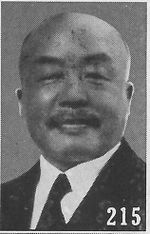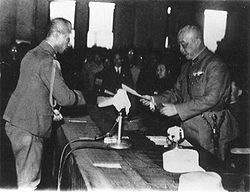- Chen Yi (Kuomintang)
-
Chen Yi
陳儀
Born 1883
Shaoxing, Zhejiang, ChinaDied June 18, 1950
Taipei, TaiwanAllegiance  Republic of China
Republic of ChinaYears of service 1902-1949 Rank General Commands held Taiwan Garrison, 19th route army Chen Yi (traditional Chinese: 陳儀; simplified Chinese: 陈仪; pinyin: Chén Yí; courtesy names Gongxia (公俠) and later Gongqia (公洽), sobriquet Tuisu (退素); 1883 – June 18, 1950) was the Chief Executive and Garrison Commander (警備總司令) of Taiwan after it was surrendered by Japan to the Republic of China, which acted on behalf of the Allied Powers, in 1945. His infamous mishandling of the tension between Taiwanese locals and Mainlanders precipitated the February 28 Incident, and he was later dismissed and executed for disloyalty (though for reasons unrelated to his tenure in Taiwan).
Contents
Early life
Chen was born in Shaoxing, Zhejiang. After studying at Qiushi Academy (now Zhejiang University), in 1902 he went to a military academy in Japan for seven years [1]. He joined Guangfuhui while in Japan. He returned to Japan in 1917 to study in a military university for three years, then resided in Shanghai. He is said to have been a "Japanophile."[1]:251
He was the first senator (總參議) and governor of Zhejiang (since October 1925). Chen was also the commander of the 19th Route Army of the National Revolutionary Army (國民革命軍第十九路軍軍長). After 1927, he worked in the Military Affairs Department (軍政部), then as the chairman of Fujian in 1933, and Secretary-General of the Executive Yuan.
Chen and Fujian
Chen served as governor of Fujian province for eight years, beginning in 1934.[1]:252 His experience in Fujian, the province immediately across the straits from Taiwan and the source of a larger percentage of Taiwan's population, was clearly a factor in Chen's selection to take control of Taiwan at the end of the war.
During his tenure in Taiwan, Chen got a taste of the complexity of ethnic and social ties among people from Fujian in other parts of Asia. He ran afoul of a powerful Chinese in Singapore, Tan Kah Kee, the leader of a large community of overseas Chinese. As a result of the conflict, Chen had to spend considerable effort and political capital fending off accusations of maladministration made against him by the influential Tan.[1]:252
Chen and Taiwan
 Chen (right) signed a surrender instrument with General Rikichi Ando (left), governor general of Taiwan, in Taipei City Hall.
Chen (right) signed a surrender instrument with General Rikichi Ando (left), governor general of Taiwan, in Taipei City Hall.
In 1935, Chen was sent to Taiwan by Chiang Kai-shek to attend "Exposition to Commemorate the 40th Anniversary of the Beginning of Administration in Taiwan," an exposition which has remained unique and unrivaled to this day, and which served as a report on the achievements of Taiwan's modernization process under Japanese rule. During his stay in Taiwan, he praised the modern public facilities and the strong economic development. Chen publicly expressed his admiration with jealousy about the advanced life quality Taiwanese people enjoyed compared with the Chinese mainlanders who suffered from prolonged war incurred destruction and lack of further modernization. After he went back to Fujian, he filed a report to Chiang Kai-shek about his visit. With his experience in Japan and Taiwan, Chen had become the first candidate as the Taiwan governor in Chiang's mind after Japan relinquished the sovereignty of Taiwan.
Under the authorization of Douglas MacArthur's General Order No. 1 [2], Chen Yi was escorted by George Kerr to Taiwan for accepting Japan government's surrender as the Chinese delegate. On October 25, 1945, joined by delegates from Allied Powers, Chen signed a surrender instrument with General Ando Rikichi, governor-general of Taiwan, in Taipei City Hall (current Zhongshan Hall). Chen Yi proclaimed that day to be the retrocession day of Taiwan which was regarded as legally controversial as Japan had not yet ceded Taiwan in any treaty until 1952.
Praise and Criticism
Chen did receive some praise for his dedication to work, his frugality, and incorruptibility.[2] He was, however, criticized for his support for his more corrupt insubordinates, and his stubborn lack of flexibility in some policies. Despite fluency in Japanese, he refused to use the language to interact with local Taiwanese elites, many of whom could not speak Mandarin, believing that the island must abandon the colonial language in favor of the new national tongue. This inability to communicate easily with his subjects and the fact he made surprisingly little effort to leave his official offices and interact with the Taiwanese society he ruled over made it difficult for him to detect the growing unrest on the island after the first year of postwar rule.[3]
Chen was later removed from the position of Taiwan governor general for his mishandling of the administration of Taiwan which resulted in the 228 Incident. In the early years of Chinese rule, rampant corruption in the new administration headed by Chen caused severe inflation, which in turn lead to widespread local discontent. Allegations of carpet bagging by new immigrants from the mainland and a breakdown in social and governmental services also served to increase tensions. As the Shanghai newspaper Wen Hui Pao remarked, Chen ran everything "from the hotel to the night-soil business." The Taiwanese felt like colonial stepchildren rather than long-lost sons of Han.
Chen and the 2/28 Incident
Anti-mainlander violence flared on February 28, 1947, prompted by an incident in which civilians were injured and shot by ROC authorities due to the violation of a ban on tobacco sales by unlicensed vendors. For several weeks after the February 28 Incident, the rebels held control of much of the main island of Taiwan. Under orders from Chiang Kai-shek, Chen deployed military troops from the mainland against the Taiwanese insurgents. By April, Chen had executed or jailed all the leading alleged rebels he could identify and catch, and his troops had prosecuted and executed (said a Taiwanese delegation in Nanjing) between 3,000 and 4,000 throughout the island. A key consequence was that "virtually all of the small group of leaders with modern education, administrative experience, and political maturity" were killed.[1] The total death toll from the incident remains in dispute and has become a political issue in recent decades (1990s and 2000s).
Career After His Return to the Mainland
Following his dismissal from the post of Taiwan governor general, Chen was employed as a consultant. In June 1948, he took the position of provincial chairman of Zhejiang province. In November, he released over a hundred communists scheduled to be executed. In January 1949, his subordinate, Tang Enbo, informed Chiang Kai-shek that Chen had advised him to rebel against the Kuomintang. Chiang immediately relieved Chen's chairmanship on the charge of collaboration with the Communists. On May 30, Chen Yi was transported to Taiwan to be imprisoned; he was later executed at Machangding (馬場町), Taipei, and was buried in Wugu, Taipei County.
Quotes from Chen
- "Mainland Chinese were advanced enough to enjoy the privileges of constitutional government, but because of long years of despotic Japanese rule, the Formosans were politically retarded and were not capable of carrying on self-government in an intelligent manner."(1947)[3]
- "It took the Japs [sic.] 51 years to dominate this island. I expect to take about five years to re-educate the people so they will be more happy with Chinese administration."(1947)[4]
- "I never forgot private enterprise. I always intended to re-establish it."(1947)[5]
Notes
- ^ a b c d Boorman, Howard L. (1968). Biographical Dictionary of Republican China. II. New York: Columbia University Press. p. 253.
- ^ Tse-han Lai and Ramon Hawley. A Tragic Beginning: The Taiwan Uprising of February 28, 1947 (Stanford University Press, Stanford, 1991), 78.
- ^ Tse-han Lai and Ramon Hawley. A Tragic Beginning: The Taiwan Uprising of February 28, 1947 (Stanford University Press, Stanford, 1991), 79-80.
References
Tse-han Lai and Ramon Hawley. A Tragic Beginning: The Taiwan Uprising of February 28, 1947 (Stanford University Press, Stanford, 1991)
See also
Categories:- 1883 births
- 1950 deaths
- 228 Incident
- Executed Chinese people
- Executed politicians
- People executed by Taiwan
- People from Shaoxing
- Kuomintang politicians in Taiwan
- Zhejiang University alumni
- Republic of China politicians from Zhejiang
- Governors of Fujian
- Governors of Taiwan
Wikimedia Foundation. 2010.
